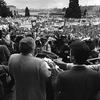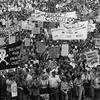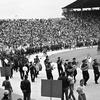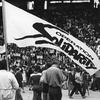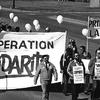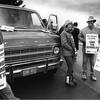18. Operation Solidarity
Canada’s long run of postwar abundance came to an end in the early 1980s. The country found itself mired in the worst economic downturn since the Depression. The malaise was particularly hard on resource-dependent British Columbia. In 1982, the province’s real GDP fell an improbable 6.1 percent, unemployment climbed significantly above the national average and galloping inflation was putting pressure on both government spending and unions trying to keep pace at a time when resource revenue had been cut in half. Far from downhearted, however, Bill Bennett and his advisers also saw the recession as an opportunity to slash the public sector and curb the power of their unions. On February 18, 1982, the premier announced the province’s first public-sector wage-control program. It was the opening shot in what became a consuming crusade to force workers to accept what Bennett called “the new economic reality.”
Wage limits under the Compensation Stabilization Program (CSP) were initially rather generous, reflecting an inflation rate of 12.9 percent and average settlements of 15 percent in the private sector. Affecting two hundred thousand public employees, annual wage increases were to be held between 8 and 14 percent. But labour was outraged by the interference in free collective bargaining. “To hell with him,” burst out BC Fed president Jim Kinnaird, moments after Bennett’s announcement. “We’ll give him a confrontation on this one.”
Ignoring Kinnaird’s hawkish response, the government moved in short order to further restrict wage limits to public employers’ “ability to pay”—whatever that meant. The program was to last two years. Former LRB vice-chair Ed Peck was appointed as “wage czar,” with the power to roll back settlements not within the CSP’s vague and shifting guidelines, dubbed “the Rubber Room” by some wags in the media.
The forty-thousand-member BC Government Employees’ Union led off negotiations in the new environment. Coming off a three-year contract that had been surpassed by other agreements and eroded by inflation, the BCGEU was seeking major gains in a one-year deal. Under the slogan “Catch Up, Keep Up,” the union demanded a 14 percent wage increase, two cost-of-living adjustments and a reduction in the ten thousand auxiliaries that allowed the government to avoid hiring full-time employees.
When talks went nowhere, a number of labour firsts soon followed. The largest strike vote in BC history, involving 488 polling stations in 192 communities and 86 Labour Relations Board monitors, produced an overwhelming 89.6 percent vote in favour of a strike. At a minute past midnight on August 6, BCGEU members hit the bricks. It was the union’s first all-out strike. The government had offered 6.5 and 5 percent increases over two years, contingent on a 4 percent boost in productivity. When Bennett claimed rank-and-file members favoured the package, BCGEU general secretary John Fryer put it to a vote. The result was 93 percent “no.”
In keeping with the strike’s historic nature, Fryer employed some unusual manoeuvres that had veteran union observers shaking their heads. First, “as a show of good faith,” the union went back to work on August 12 to facilitate a resumption of negotiations. When talks stalled once more, a second full-scale strike resumed August 31, only to end after twenty-four hours in favour of rotating strikes. Finally, on Jack Webster’s widely watched TV show, pressed by Webster to justify BCGEU demands amid high unemployment and a stumbling economy, Fryer said the union would lower its demands if the money saved by the government went into job creation. The proposal was entirely Fryer’s own, with no notice to a less-than-pleased bargaining committee.
But Fryer’s off-the-cuff gambit sparked interest from the government. Contract talks resumed. The quirky TV proposal was quickly forgotten, and the two sides hammered out a new deal. The government stuck to its 6.5 and 5 percent wage offer but over fifteen months rather than two years, and fifteen hundred auxiliaries were given full-time status. Although short of union expectations, it was enough of a victory to whet the appetite for fiercer struggles ahead.
In the meantime, the modernized Social Credit machine had tested its new “high-tech” political machinery in a 1982 Kamloops by-election that all pundits had ceded to the NDP. Relying on sophisticated polling, phone banks, hundreds of volunteers and skillful presentation of Bill Bennett’s unwavering restraint message, the party’s efforts sent local Rube Band trumpeter Claude Richmond into the legislature. The same machine was oiled and primed for action when Bennett called a provincial election the next spring. The theme would be restraint: Bill Bennett staring down the recession, determined to cut spending and rein in the unions.
Yet early on, little went right for Bennett, while Dave Barrett was greeted with enthusiastic crowds wherever he went. With two weeks to go, the NDP seemed on a roll to victory. Then Barrett’s blunder on a union issue turned the election around. The NDP leader promised, if elected, to scrap the government’s wage-control program as quickly as possible rather than let it run its course. It was a huge political gaffe. Not only was the program popular with hard-hit British Columbians, ending it in the middle would be unfair to unions already affected. Barrett scrambled to clarify his position, but it was too late. A revived Bennett had his restraint message back on track. Social Credit cruised home with a satisfying majority.
No one could have guessed what was coming next. Sensing this term would be his last, Bennett prepared to unleash a full-frontal assault on unions and government itself. At a cabinet retreat, egged on by the right-wing Fraser Institute, the premier urged ministers to be bold in slashing government. When labour minister Bob McClelland tentatively gave voice to his long-held distaste for the Human Rights Commission, he was encouraged to go after it. Heartened by the response, ministers began happily hacking away at other elements of government they detested. Their efforts were unveiled to a stunned population on budget day, July 7, 1983.
There had been no sense of the storm to come during the traditional budget lockup for the media. Reporters trooped back to the legislature, their stories written in advance, waiting for finance minister Hugh Curtis to begin his budget address before sending them on their way. But once Curtis stopped speaking, all hell broke loose. One by one, ministers rose in the legislature to introduce a new bill. When they were finished, no less than twenty-six pieces of legislation had been put forward, representing a premeditated strike on all those elements of society the Socreds had never really liked: social justice, community activists, rights of the disadvantaged and above all, public employees and their unions.
The Human Rights Branch and the Human Rights Commission were axed, commissioners and staff fired on the spot and told to turn in their keys before the day was out. The rentalsman, established under the NDP to safeguard tenant rights, was abolished, along with rent controls. Landlords were given the right to evict tenants at will. Gone too were the Employment Standards Board, the Alcohol and Drug Commission, vehicle testing stations, the BC Harbours Board and legislative scrutiny over Crown corporations. The government also strengthened its hand in education, assuming power to oversee school district budgets and fire elected boards unwilling to co-operate.
The most jaw-dropping measures were aimed at public-sector unions. Wage controls were extended indefinitely. Bill 2, the Public Sector Labour Relations Act, pretty much gutted the BCGEU’s contract of all employee rights beyond wages and benefits. But the pièce de resistance was Bill 3, the Public Sector Restraint Act. In blunt language that provoked gasps of disbelief, the bill gave all public-sector employers in the province, including the government, the power to fire employees without cause. No province in Canada had mounted such a multi-pronged, single-day assault on so many existing rights—rights most British Columbians had taken for granted. Not a word of it had been mentioned during the election campaign, a tactic praised by none other than Milton Friedman, economic guru of neoliberalism, who loved what Bennett was doing.
The timing could not have been better. Dave Barrett had announced his intention to quit. The BC Federation had also lost its main man when Jim Kinnaird died suddenly of a heart attack in February. His replacement was Art Kube, the CLC’s stolid regional education director, who had been on the job for only two months. Like everyone, Kube was caught off guard by the Social Credit onslaught. He issued a rote response and not much else. But that was not a sign of what lay ahead.
Within days, George Hewison of the UFAWU, head of the labour council’s unemployment committee, called a meeting at the Fishermen’s Hall. More than a hundred people showed up, spilling out of the meeting room. They agreed to hold a demonstration on Saturday, July 23. Community activists, horrified at what was happening to basic rights and social services in the province, were just as fast off the mark. The day after Hewison’s meeting, hundreds came to a forum addressed by fired members of the Human Rights Commission. The next day, Women Against the Budget was formed, a broad-based umbrella organization of activist women that was a force throughout the next four months. Small gatherings, large gatherings, discussion groups, planning meetings and action caucuses seemed to be everywhere.
Getting up to speed, Kube announced that the Fed would be leading a major campaign to oppose the budget. Not even Art Kube knew just how “major” it would become. On Friday, July 15, he convened a historic one-day convention of all labour organizations in British Columbia. For the first time, independent Canadian union delegates sat in the same hall as the Federation’s international union affiliates, their animosities set aside for a common purpose. Teachers were there, nurses, university professors, even doctors, who had also been singled out by the budget. A ten-point action program emerged from the convention, plus an initial $1 million war chest and the Polish-born Kube’s brilliant branding of the swelling protest as “Operation Solidarity,” derived from the Solidarnosc union protests in Poland. With its distinctive red and white banner, Operation Solidarity was soon a household name and galvanizing force across BC.
The meeting at the large Operating Engineers Hall in Burnaby was the start of Art Kube’s emergence from the shadows of union backrooms into the public spotlight. For the next four months, he became as well known as the premier, leading a mass movement that rallied hundreds of thousands of British Columbians, many of whom had never protested anything before. It was the cause of his life, and the heavyset former union fixer, who had survived a harrowing wartime childhood fleeing the Nazis through a bombed-out Germany before landing in Canada on a whim, rose to the occasion with a drive and commitment few could have foreseen.
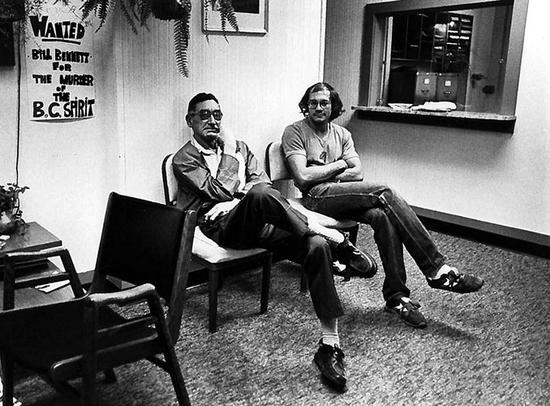
The first major action under the Operation Solidarity banner took place in Kamloops at the sprawling Tranquille residential complex for people with developmental disabilities. On July 19, union rep Gary Steeves was called to a meeting by senior government officials in Vancouver and told Tranquille was going to close. All six hundred BCGEU members would be laid off with no regard for their contract rights. It was as if Bills 2 and 3 were already law. Steeves left the meeting so dumbfounded and lost in thought that he ran a stop sign and caused a minor accident. He quickly boarded a flight to Kamloops for a mass membership meeting at Tranquille that night. When workers heard about the pending closure, with no apparent plan for the 325 residents or their own future, they eagerly embraced the idea of taking over the facility themselves.
Much in the manner of the stirring TWU occupation of BC Tel three years earlier, Tranquille employees evicted managers from their offices, changed the locks and put up signs reading, “Under New Management.” At a special courtyard ceremony, they replaced the BC flag with a makeshift BCGEU/Tranquille standard fashioned from a pale blue bedsheet. The occupation lasted twenty-two days.
The general manager, holed up in an outbuilding with other bosses, dutifully signed off on expenses, including workers’ salaries. When the creaking rooftop air conditioner in the cerebral palsy ward gave out in the baking summer heat, Steeves was able to persuade the manager to approve a $350,000 replacement. “That was the only time I was frankly nervous,” said Steeves of the large purchase, “but we had to have something for the residents.”
The occupation received wide coverage, but the BCGEU knew it could not last forever. After three weeks, the union agreed to return Tranquille to its overseers. In return, the layoff issue was shunted to negotiations about to begin in Vancouver and the union extracted a promise of no reprisals. On the pressing matter of the residents’ future, the government gave a first-of-its-kind commitment to work with community care advocates to prepare an individual placement plan for each one. “That was unheard of,” said Steeves, who camped out in a boardroom throughout the occupation. “We did stuff that had never been done before.” The union flag came down on August 10. Government employees from all over the city attended a celebratory downtown rally, hailing retention of the workers’ seniority and bumping rights. When Tranquille finally did close, many found government jobs elsewhere.
In Vancouver, Kube’s request to delay the hastily called July 23 protest to ensure a better turnout was rebuffed. The march went ahead. More than twenty thousand boisterous demonstrators took to the streets on a beautiful, sunny afternoon, twice the number expected. Four days later, an estimated twenty-five thousand people amassed on the lawn of the legislature and surrounding streets for the largest-ever protest in Victoria. Many were government employees who had walked off their jobs to attend the ninety-minute rally. Also taking time off were hospital employees, bus drivers, municipal workers and at least one private-sector group—four hundred BC Tel employees. Local transit was shut for three hours. All liquor stores from Nanaimo south were closed. “This is bigger than the Queen,” said an impressed police officer.
Among the sea of signs were many referring to BC as “Canada’s Poland,” where the communist government had crushed the labour movement. There were podium warnings of a long, intensive campaign against the twenty-six bills, industrial relations chaos and civil disobedience. That prospect was raised by CUPE president Grace Hartman. “We may end up in a position where we might have to resort to [it],” professed Hartman, the first woman to head a large national union, who at sixty-two had spent thirty days behind bars for defying a court injunction. “We cannot be afraid.” Her pronouncement drew a roar of approval.
“Black Thursday” sparked a summer of protests, rallies, meetings and feverish community organizing, the likes of which had never been seen in BC. In Social Credit strongholds far from Vancouver, they marched—four thousand in Kamloops, four thousand in Kelowna, two thousand each in the dusty, spirited Cariboo communities of Williams Lake and Quesnel. Even Fort St. John and Dawson Creek, the heart of free-enterprise thinking in BC, held substantial protests, ignoring catcalls from locals in passing pickup trucks. “It took a lot of courage in that environment,” said Steve Koerner, a representative of the Hospital Employees’ Union. “But we had no choice but to fight the legislation. We had done nothing to deserve it.” Dozens of brief wildcat strikes by BCGEU members also took place across the province as closures, cutbacks and government layoffs accumulated.
In the midst of it all, the otherwise unflinching Bill Bennett gave an inch. Perhaps he was shaken by a dramatic newspaper ad showing the black silhouette of a police officer complete with cap, gun and holster. In the middle of the silhouette were the words, “How will I investigate criminal allegations against politicians when I can be fired without cause? Think about Bill 3.” The ad was paid for by the BC Federation of Police Officers. Responding to universal criticism over giving employers the right to fire anyone without cause, the government removed the problematic phrase from Bill 3, clarifying that the bill was to govern layoffs, not firings. This was scant comfort, however, to the sixteen hundred BCGEU members who had already been singled out for dismissal the moment their contract expired on November 1. Under Bill 3, they would have no seniority or bumping rights.
The long, hot summer hit its peak on August 10 at Empire Stadium in Vancouver. Public-sector workers across the city booked off to attend the gigantic, festive gathering. Buses were corralled from wherever they could be scrounged to transport trade unionists to the site. Non-union members of the public and activists also streamed to the stadium to celebrate their solidarity and vent their rage against the government. Much of the city, including public transit and liquor stores, was shut for the afternoon. An estimated forty thousand people crammed every nook and cranny of the creaking old stadium and onto the field—far more than The Beatles had drawn in 1964.
Just when it appeared the stadium could not hold one more person, in marched several hundred uniformed firefighters, led by their rousing brass band, followed by hundreds of bus drivers, also in uniform, and a thousand CUPE outside workers. As the band played on, people were crying with joy and cheering their hearts out. Ovations reverberated through the stadium in great ascending waves as the procession wound its way around the infield track. For many, it was the emotional highlight of the entire Operation Solidarity movement, a moment when anything seemed possible.
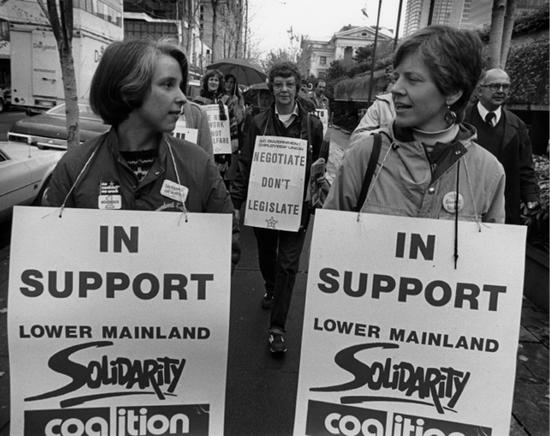
Much of the energy and momentum came from outside trade union ranks. A key element in Kube’s strategy was to harness community and social justice advocates to the movement by concentrating on all twenty-six bills rather than just those affecting unions. Kube enlisted one of the fired human rights commissioners, Renate Shearer, as his main contact with those fighting against the budget’s erosion of basic rights and social services. In mid-July, 450 activists had crowded into a Vancouver meeting hall to form the Lower Mainland Budget Coalition, while the militant Women Against the Budget continued its aggressive organizing. No community of any size was without some form of anti-budget group. On August 3, Kube, Shearer and a few others drew together all the diverse strands for a large conference at the same Operating Engineers Hall where Operation Solidarity had been born.
What emerged was a separate, BC-wide organization called the Solidarity Coalition. Operation Solidarity was now the union arm of the protests, while the coalition, assisted by labour, carried the fight on social issues. Its three co-chairs were Kube, Shearer and Father Jim Roberts, a liberal theologian who taught religious studies at Langara College. The coalition received $20,000 a month from the labour movement, enough for staff and office space plus three full-time organizers: anti-poverty fighter Jean Swanson from the Hospital Employees’ Union; Clay Perry, legislative director for the Canadian arm of the IWA; and BC Fed staffer Gerry Scott. The alliance between Operation Solidarity and the Solidarity Coalition represented an unprecedented partnership between trade unionists and community activists.
However, after the high of Empire Stadium, Operation Solidarity appeared to disappear from view. Information meetings, an advertising campaign and a province-wide petition drive that sucked up a lot of effort with little reward created a lull after all the fireworks. The government took heart during the letup, dismissing the protesters as disgruntled British Columbians refighting the last election. After weathering Operation Solidarity’s summer-long barrage, Social Credit was ready to move ahead with a full-court press to ram its budget bills through the legislature. Beginning September 19, the government imposed a punishing agenda of twenty-four-hour sittings and closures to get its way. Tempers frayed during the Socreds’ all-out offensive against legislative niceties. At one point, Dave Barrett was dragged from the legislature for resisting an order from rookie speaker John Parks to leave and was dumped, rump first, on the corridor’s hard floor. Many of the bills were passed in the pre-dawn hours between 3 and 6 a.m.
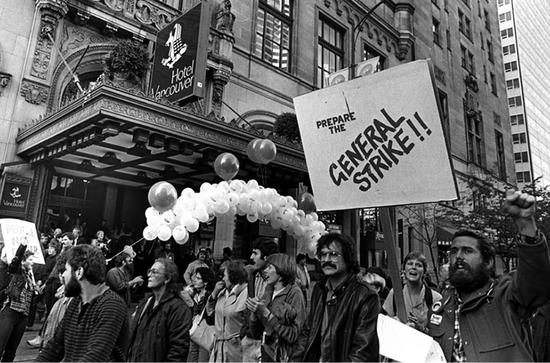
By then, attention was beginning to shift for the first time to actual negotiations. Contract talks between the government and the BCGEU began October 3. Staring both sides in the face was midnight, October 31—Hallowe’en. That’s when the union’s master agreement expired, and pink slips previously handed to sixteen hundred government employees would take effect. Armed with an 87 percent strike vote, it was also the BCGEU’s strike deadline. The union was adamant: there would be no new agreement without an end to Bills 2 and 3.
As talks continued, plans were underway for Operation Solidarity’s biggest gamble. More than a month after anti-government dissent had soared to rare heights, leaders seemed uncertain of their next move. Frustrated, members of the Solidarity Coalition managed to convince a reluctant Kube and other Solidarity leaders to jointly sponsor a public protest in the streets of Vancouver on October 15. That would coincide with the Socreds’ annual convention at the Hotel Vancouver. Privately, Kube worried the protest might be a flop, which would be fatal to the movement’s credibility. Three months after Social Credit’s July budget bombshell, how much fight remained?
He need not have worried. In yet another example of the depth of people’s commitment, a mind-boggling sixty thousand people wound their way through downtown Vancouver, the largest anti-government protest in the history of a city that had seen so many over the years. As they wound in unending waves past the Hotel Vancouver, where Social Credit delegates and an occasional cabinet minister ventured out from the lobby to take in the view, the marchers chanted, “Socreds Out! Socreds Out!” The size of the turnout changed the game. Clearly, Operation Solidarity and the Solidarity Coalition were still in business. High-level strategy sessions to take the struggle to another level were soon in motion. There were simply too many signs reading “Prepare the General Strike” to be ignored. Operation Solidarity’s steering committee began holding daily breakfast meetings at the Villa Hotel in Burnaby.
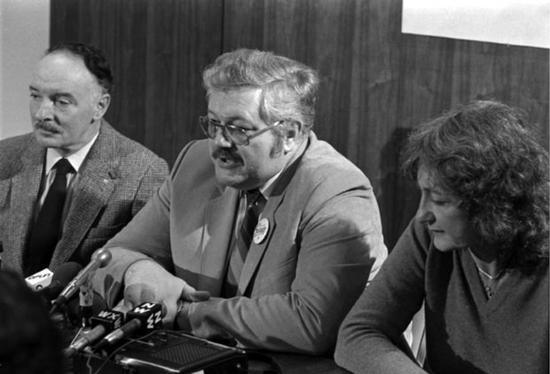
Three days after the march, BCGEU contract talks broke down in acrimony. Sensing the situation was becoming a tad too unpredictable, Premier Bennett took free time on BCTV to try to calm things down. Just six days after his defiant declaration to cheering Social Credit delegates that “we will never turn back,” Bennett announced an adjournment of debate in the house “to let tempers cool off.” He suggested the pending layoffs might be delayed if there were progress at the bargaining table. Negotiated exemptions from odious sections of Bill 3 might be possible. The new message from the normally combative premier was now consultation over confrontation. Sort of. “You can’t picket your way to prosperity,” he admonished the forces arrayed against his government.
Negotiations resumed the next day at the Labour Relations Board in Vancouver. Bennett’s deputy minister Norman Spector joined the talks. It was a sign the government was playing for keeps, but also a sign that Bennett wanted a deal. Just days before the union’s strike deadline, former Mine, Mill and Smelter Workers’ Union representative Vince Ready took up the challenge to act as mediator. Still, not much moved.
Meanwhile, several hundred Solidarity Coalition delegates had held their first province-wide conference. They passed a resolution calling for job action “up to and including a general strike” to force the government to withdraw all twenty-six bills. This irritated many private-sector union leaders, notably Jack Munro of the IWA, who felt non-trade unionists had no business demanding their members take on the struggle. But the militant mood at the gathering was infectious, buoyed no doubt by the Vancouver protest a week earlier. When Kube reminded delegates that any action by the labour movement would be primarily aimed at Bills 2 and 3, not the entire package of Social Credit legislation, some responded with anger.
With a BCGEU strike looking increasingly likely, Operation Solidarity stepped into the breach. After weeks of closed-door deliberations and countless revisions as the timetable for affected unions bounced around, Kube revealed the organization’s final “program of action” to support the BCGEU and the quest to kill Bills 2 and 3. Province-wide walkouts were at the heart of the action plan. They would be triggered November 8, if BCGEU members were still on strike. Rather than a big bang by all public-sector unions, Operation Solidarity opted for an escalating series of strikes.
The education sector, including thirty thousand teachers, would be the first group out. On November 10, unionized employees at the province’s many Crown corporations would leave their jobs. Week two would be even more dramatic. On Monday, November 14, BC’s ferry workers, municipal employees and other related groups were scheduled to walk out; and the day after that, all public transit in the Lower Mainland was due to be shut down. Finally, at the end of the week, the province’s large public-health sector would be targeted, with hospital workers pouring off the job. By then, a total of two hundred thousand public employees in the province would be on the street, as close to an all-out general strike as BC had ever come. Private-sector unions pledged to join the fray should any public-sector worker be punished for joining the protest strike.
What had begun in the early days of summer was nearing its climax in grim, rainy November. Mike Kramer, the BC Federation of Labour’s blustery secretary-treasurer, publicly warned the price of poker would go up once the Operation Solidarity walkouts were launched. All twenty-six bills would be back on the table. The BCGEU rebuffed last-minute entreaties from Bill Bennett to put off its strike. Picket lines went up on the stroke of midnight, October 31. Spirits were high. After so much talk, there was a real strike at last, by the province’s largest union.
Unions pinpointed by Operation Solidarity for job action had been holding their own strike votes. It was not always easy. Hesitant about leaving their jobs for uncertain goals, BC teachers voted just 59 percent in favour of a strike. The teachers’ low vote undoubtedly caused a government sigh of relief. Privately, Operation Solidarity leaders blanched too. If the teachers’ November 8 walkout turned into a fiasco, with significant numbers going to work, it was difficult to see any future for labour’s action program.
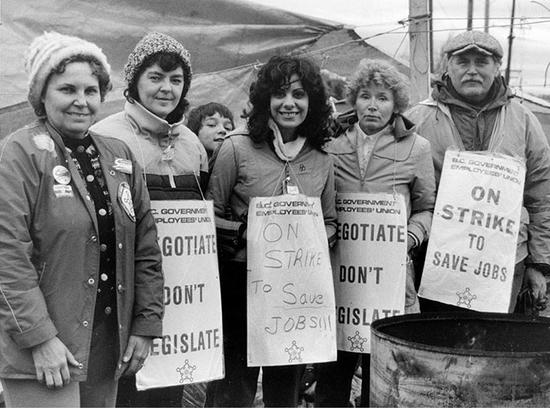
Operation Solidarity leaders desperately sought some sort of settlement that would avoid their pending date with destiny. As November 8 neared, Kube thought he had a deal. Private negotiations involving many of the main players had produced an agreement between the North Vancouver School Board and the BCTF’s North Vancouver local that would exempt teachers from the draconian layoff provisions of Bill 3. The idea was to use it as a template for similar Bill 3 exemptions for all other public-sector bargaining units in the province.
It seemed incongruous that a single side-deal in North Vancouver would be enough to end the most concerted citizen resistance in the province’s history. But Kube and other union leaders, with their focus on Bill 3 over all other bills, were convinced this strategy would fly. Instead, Bill Bennett the street fighter called Operation Solidarity’s bluff. Sensing its eagerness to avoid a confrontation and taking sustenance from the teachers’ low strike vote, the government scuttled the North Vancouver agreement. Bennett reasoned the movement would collapse on its own.
Crushed, an ashen Kube summoned reporters late on Monday afternoon, November 7. In a sombre voice he announced that “unfortunately” Operation Solidarity’s strike agenda would begin as scheduled the next morning. There were no ringing words of defiance. At a meeting in New Westminster that evening, Kube broke down in tears. Emotionally and physically exhausted after 120 days of long hours and countless meetings, under almost unbearable pressure, the indomitable labour leader was spent. He was diagnosed with pneumonia and ordered to bed.
Everything hinged on the teachers’ response. They had never had more than a one-day province-wide strike before. More than 40 percent of the BCTF membership had voted against it. The situation became even more problematic when the Vancouver School Board obtained a late injunction banning the BCTF’s largest local from picketing, making it easier for reluctant teachers to report for work. “We’re going to kick their ass,” crowed school trustee (later prime minister) Kim Campbell.
But something remarkable happened. In the early hours of Tuesday morning, phones began ringing across the city, rousing Solidarity Coalition activists from their sleep. The word went out: “You’re needed on the line at every public school in Vancouver.” Before dawn, groups of mostly women activists huddled in the miserable, steady rain, ready to go. Hastily worded picket signs were handed out. When teachers and other school employees arrived that morning, they found their schools ringed with pickets. Almost no one crossed.
Similar support for the walkout reverberated at schools across BC. The teachers stayed out; they had delivered in a way few had foreseen. Thousands of other education workers, including college faculty, university clerical staff and public school maintenance employees were also off the job. On Thursday, the strike was joined by several thousand Crown corporation employees, including those at the Insurance Corporation of British Columbia (ICBC). Euphoria reigned. If the planned ferry shutdown took place on the Monday, followed by public transit workers on Tuesday and hospital employees at the end of the week, who knew what might happen?
It was crunch time, and all of Canada was watching. At the Labour Relations Board, tense and at times vitriolic negotiations to hammer out a new BCGEU contract had left everyone bleary-eyed and punch drunk, as mediator Vince Ready hounded the parties to get it done. The board’s large reception area was packed with lights, cameras, microphones and scores of reporters thirsty for any scrap of news. Whenever someone emerged from behind closed doors, even if only for a bathroom break, the throngs followed like a large, twisting snake. At the same time, unbeknownst to all but a few, secret discussions were going on in the upper-floor office of board chair Stephen Kelleher. The government now accepted that something had to be done beyond settling with the BCGEU in order to satisfy Operation Solidarity and put a halt to its escalating job action.
With Kube sidelined, Operation Solidarity was represented by Mike Kramer and a worried Jack Munro, increasingly nervous that the union movement was headed over a cliff and angry that social activists were expecting their battles to be fought on the backs of unions. The government side was mostly Norman Spector, who shuttled back and forth between BCGEU talks and those with Munro and Kramer upstairs. From its original lofty demand that all twenty-six bills be withdrawn, by Friday Operation Solidarity appeared ready to accept a deal that included the killing of Bill 2, exemptions to Bill 3’s layoff measures, a government commitment to keep salary savings from the teachers’ walkout in the education system, and promises of consultation on the bills covering tenant and human rights. It was also agreed that once the government employees had an agreement, Jack Munro would head to Kelowna to meet Premier Bennett to confirm details of the package.
Down on the first floor with the BCGEU, momentum was building for a settlement. An experienced mediator, Ready could sniff when parties were ready to deal, and his well-worn practice was to keep them at the table until it was done. As the two bargaining committees went at each other for one last round-the-clock session, their large negotiating room reeked of stale pizza, too many cigarettes and too few showers. At last on Sunday afternoon, November 13, Spector and the BCGEU’s Cliff Andstein wearily announced the two sides had reached a tentative agreement. The money wasn’t much, but it was better than previous government offers. More importantly, the government agreed to let Bill 2 die on the order paper while providing an exemption to Bill 3 that ensured layoffs would proceed according to seniority and the right of laid-off employees to transfer to available jobs across the entire workforce. Firing without cause and without regard to seniority was dead and buried.
Munro swung into action. Taking the Fed’s Gerry Scott with him, the imposing IWA leader boarded a government jet along with Spector and flew to Kelowna to meet Bill Bennett that evening in his living room. Given the previous understanding with Spector, Munro expected a relatively easy time of it. But things had changed. On Saturday, the Vancouver Sun disclosed the secret talks between Operation Solidarity and the government, along with details of a possible package to end the walkout. Bennett’s phone began ringing. Some cabinet ministers and Social Credit caucus members were furious to learn the government was talking without their knowledge to people they considered rabble-rousers and lawbreakers. The calls reinforced Bennett’s own instinct to give virtually nothing to Solidarity, still sensing they wanted out of the imminent escalation more than he did.
In the glare of TV lights, Bennett greeted Munro on the porch. For the next three hours, the province held its breath, unsure whether there would be peace on Monday morning or another major step toward a general strike. Behind the closed drapes of Bennett’s living room, Munro found himself in a tough position. There were a few nods on consultation and an apparent willingness to keep strike savings in the education system, but Bennett would agree to put nothing in writing. Using the upstairs phone in the Bennetts’ bedroom, staring at the premier’s dressing gown and slippers in the closet, Munro consulted BC Fed leaders back in Vancouver. He also phoned the ailing Art Kube. Kube advised him to “get the hell out of there,” as did Gerry Scott, but the other BC Fed officials told Munro to get what he could.
While Munro and Bennett dickered, there was a celebratory mood out at BCGEU headquarters in Burnaby. Although Cliff Andstein had made it clear that union picket lines would not come down until there was a settlement with Operation Solidarity, government employees had already won their battle. Someone brought champagne and the party was on, to the disgust of some members of the Solidarity Coalition on hand who felt their issues slipping away. Back in Kelowna as the clock ticked toward 10 p.m., Munro made one more report to the BC Fed’s steering committee on what he had achieved. On behalf of Operation Solidarity, the committee voted to accept, though the decision was not unanimous. Shortly before 10:30, Munro and Bennett appeared on the premier’s darkened porch, lit up by camera lights, and announced a settlement of sorts. Bennett called it “an avenue for resolving the difficulties.” Details of what became known as the Kelowna Accord were sketchy. But crystal clear was that Operation Solidarity’s mass protest movement was over. The picket signs were coming down.
It was a tough moment for leaders of the Solidarity Coalition, who had poured so much into the four-month struggle. They were not consulted, nor were they privy to any of the high-level talks aimed at ending the looming general strike, which had been sold to the public as being about more than trade union issues. Renate Shearer, along with union representatives Leif Hansen and Joy Langan, arrived at the coalition’s downtown office to provide what details there were. “It was a terrible night,” said Shearer afterward. “People believed and they cared and they were desperate, and everything we had come together for was still up in the air.” At a Lower Mainland Solidarity Coalition meeting at the Fishermen’s Hall the next evening, a recovered Kube and Mike Kramer were booed, denounced and accused of selling out. The two labour leaders left.
Beyond the demise of Bill 2 and an agreed process to negotiate exemptions from the worst of Bill 3, the Kelowna Accord included a commitment to use some of the salary savings from the teachers’ strike on education programs, and unwritten promises of consultation or advisory committees on human and tenants’ rights, the next provincial budget and any changes to the labour code. With nothing on paper or recorded, however, it was easy for the government to renege on even these minimal terms, which by and large they did. The resulting ill will surfaced at the next convention of the BC Federation of Labour. Munro, whose role in the Kelowna Accord and intemperate remarks about coalition activists made him a target, lost the IWA’s customary first vice-president slot on the Fed executive to his long-standing rival, Art Gruntman of the Canadian Paperworkers Union.
The anticlimactic end to Operation Solidarity’s unprecedented fight against the government has tended to shroud what was arguably one of the noblest chapters in the history of the BC labour movement. Lost in the activists’ understandable anger over the failure of the Kelowna Accord to achieve anything on social issues was a trade union victory. The government’s attempt to run roughshod over union rights was stopped in its tracks. By standing shoulder to shoulder, the labour movement forced the implacable Bill Bennett to back down on both Bill 2 and Bill 3. And although large numbers of layoffs did take place, all proceeded according to the terms of their union contracts. The province’s teachers were also victors. By walking out in such numbers, risking legal punishment for what was an illegal strike, they earned their trade union stripes once and for all. The BCTF has been among the most militant of BC unions ever since.
Finally, Bennett took a big hit in popularity. The summer of chaos provoked by the breadth of his government’s simultaneous attack on so many rights, followed by a near general strike, vexed the public, which tended to blame the premier more than Operation Solidarity for the turmoil. Confrontation fatigue set in. This, too, was a legacy of Operation Solidarity. For the many thousands of British Columbians who took part, they could look back with pride at being part of a people’s movement that has come around only once in the province’s history.

